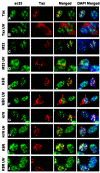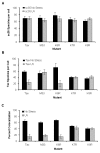Ubiquitination of HTLV-I Tax in response to DNA damage regulates nuclear complex formation and nuclear export
- PMID: 18081936
- PMCID: PMC2234431
- DOI: 10.1186/1742-4690-4-95
Ubiquitination of HTLV-I Tax in response to DNA damage regulates nuclear complex formation and nuclear export
Abstract
Background: The HTLV-I oncoprotein, Tax, is a pleiotropic protein whose activity is partially regulated by its ability to interact with, and perturb the functions of, numerous cellular proteins. Tax is predominantly a nuclear protein that localizes to nuclear foci known as Tax Speckled Structures (TSS). We recently reported that the localization of Tax and its interactions with cellular proteins are altered in response to various forms of genotoxic and cellular stress. The level of cytoplasmic Tax increases in response to stress and this relocalization depends upon the interaction of Tax with CRM1. Cellular pathways and signals that regulate the subcellular localization of Tax remain to be determined. However, post-translational modifications including sumoylation and ubiquitination are known to influence the subcellular localization of Tax and its interactions with cellular proteins. The sumoylated form of Tax exists predominantly in the nucleus while ubiquitinated Tax exists predominantly in the cytoplasm. Therefore, we hypothesized that post-translational modifications of Tax that occur in response to DNA damage regulate the localization of Tax and its interactions with cellular proteins.
Results: We found a significant increase in mono-ubiquitination of Tax in response to UV irradiation. Mutation of specific lysine residues (K280 and K284) within Tax inhibited DNA damage-induced ubiquitination. In contrast to wild-type Tax, which undergoes transient nucleocytoplasmic shuttling in response to DNA damage, the K280 and K284 mutants were retained in nuclear foci following UV irradiation and remained co-localized with the cellular TSS protein, sc35.
Conclusion: This study demonstrates that the localization of Tax, and its interactions with cellular proteins, are dynamic following DNA damage and depend on the post-translational modification status of Tax. Specifically, DNA damage induces the ubiquitination of Tax at K280 and K284. Ubiquitination of these residues facilitates the dissociation of Tax from sc35-containing nuclear foci, and stimulates nuclear export of Tax through the CRM1 pathway.
Figures






Similar articles
-
Genotoxic stress and cellular stress alter the subcellular distribution of human T-cell leukemia virus type 1 tax through a CRM1-dependent mechanism.J Virol. 2006 Jul;80(13):6657-68. doi: 10.1128/JVI.02270-05. J Virol. 2006. PMID: 16775353 Free PMC article.
-
The Sumo-targeted ubiquitin ligase RNF4 regulates the localization and function of the HTLV-1 oncoprotein Tax.Blood. 2012 Feb 2;119(5):1173-81. doi: 10.1182/blood-2011-06-358564. Epub 2011 Nov 21. Blood. 2012. PMID: 22106342 Free PMC article.
-
HTLV-1 Tax nucleocytoplasmic shuttling, interaction with the secretory pathway, extracellular signaling, and implications for neurologic disease.J Biomed Sci. 2005 Dec;12(6):961-74. doi: 10.1007/s11373-005-9026-x. Epub 2005 Oct 14. J Biomed Sci. 2005. PMID: 16228291 Review.
-
Ubiquitination and sumoylation of the HTLV-2 Tax-2B protein regulate its NF-κB activity: a comparative study with the HTLV-1 Tax-1 protein.Retrovirology. 2012 Dec 7;9:102. doi: 10.1186/1742-4690-9-102. Retrovirology. 2012. PMID: 23217160 Free PMC article.
-
NF-kappaB activation: Tax sumoylation is out, but what about Tax ubiquitination?Retrovirology. 2012 Sep 25;9:78. doi: 10.1186/1742-4690-9-78. Retrovirology. 2012. PMID: 23009565 Free PMC article. Review.
Cited by
-
Low nuclear body formation and tax SUMOylation do not prevent NF-kappaB promoter activation.Retrovirology. 2012 Sep 25;9:77. doi: 10.1186/1742-4690-9-77. Retrovirology. 2012. PMID: 23009398 Free PMC article.
-
Wip1 and p53 contribute to HTLV-1 Tax-induced tumorigenesis.Retrovirology. 2012 Dec 21;9:114. doi: 10.1186/1742-4690-9-114. Retrovirology. 2012. PMID: 23256545 Free PMC article.
-
Mechanisms of Oncogenesis by HTLV-1 Tax.Pathogens. 2020 Jul 7;9(7):543. doi: 10.3390/pathogens9070543. Pathogens. 2020. PMID: 32645846 Free PMC article. Review.
-
Human T Lymphotropic Virus Type 1 (HTLV-1): Molecular Biology and Oncogenesis.Viruses. 2010 Sep;2(9):2037-2077. doi: 10.3390/v2092037. Epub 2010 Sep 24. Viruses. 2010. PMID: 21994719 Free PMC article.
-
Dimerization and a novel Tax speckled structure localization signal are required for Tax nuclear localization.J Virol. 2009 Jun;83(11):5339-52. doi: 10.1128/JVI.00232-09. Epub 2009 Mar 25. J Virol. 2009. PMID: 19321601 Free PMC article.
References
Publication types
MeSH terms
Substances
Grants and funding
LinkOut - more resources
Full Text Sources

